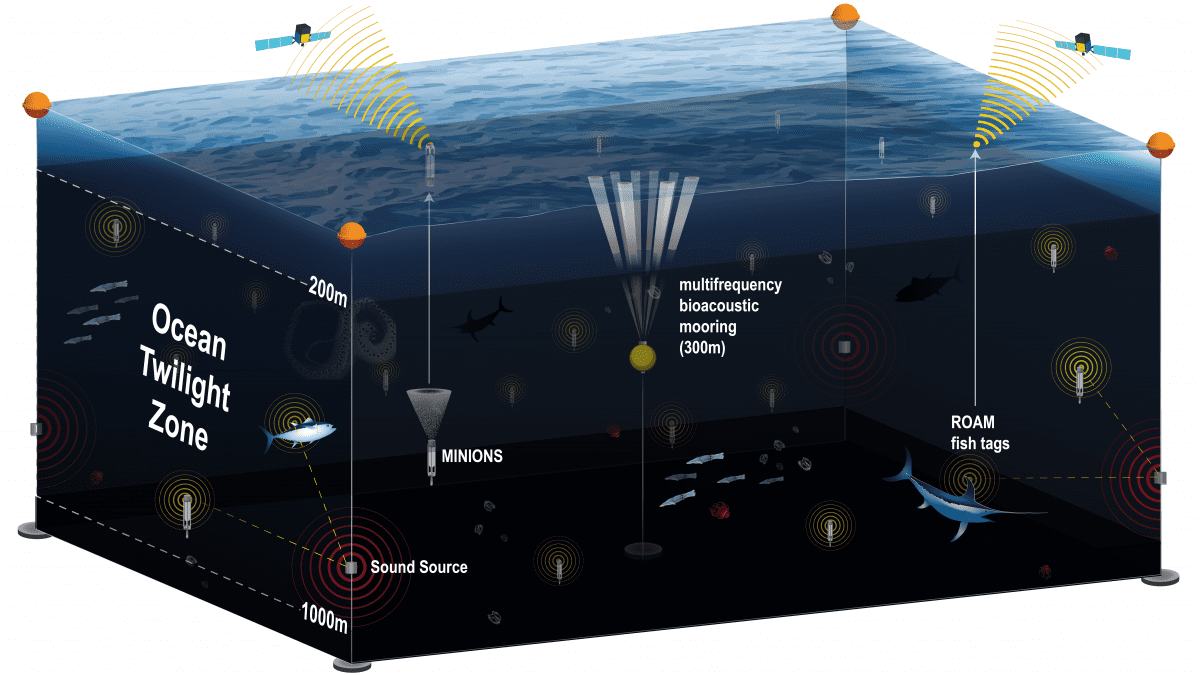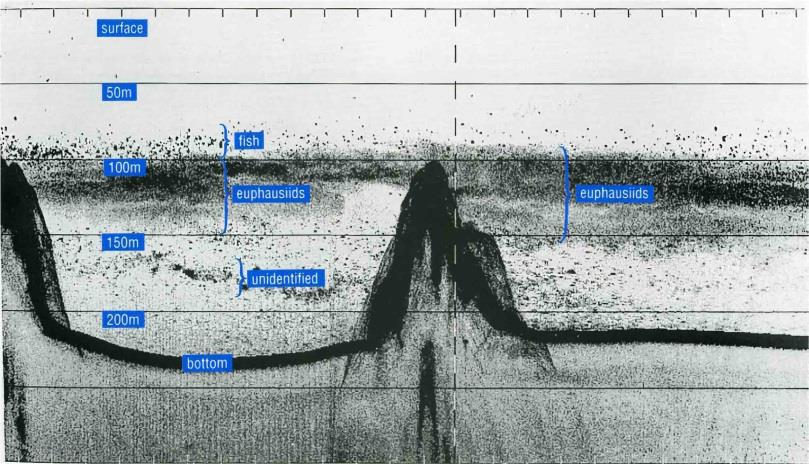Oceans, The Twilight Zone, its Wonders and Importance
Some of us may remember the TV series titled, “The Twilight Zone” with Rod Serling. It was a very popular series and ran from 1959 to 1964. Unusual sights, and events, that may have been fantasy, science fiction or reality, were a part of a mix with explanations that were, in most cases, speculative but interesting and entertaining.
Enter Woods Hole Oceanographic Institute also known as WHOI. Located in Woods Hole, MA it is a pre-eminent research center with a focus on the oceans and the role it plays in our climate and life on Earth. The research initiatives underway there are not fantasy but fascinating.
A major study now underway involves the ocean twilight zone [also called mesopelagic], which is a very dimly lit region from about 650 feet [200 meters] to 3200 feet [1000 meters] feet below the surface.
See the image, labeled on the left, “Ocean Twilight Zone” [courtesy WHOI]. It is this cubic area of the ocean that is now the subject of a new intensive study using a variety of sound sources, optical sensors, geochemical sensors, bioacoustic moorings, fish tags and more. The information gathered is sent via buoys on the ocean surface to satellites for distribution to scientists. This network of sensors will collect around-the-clock data over months or, hopefully, longer.
The enormous study area will encompass some 155,000 square miles of the northwest Atlantic Ocean off the coast of North America. This research is critical since Earth’s oceans cover some 70% of our planet’s surface and our knowledge of it is confined mostly to the ocean’s surface and the first few hundred feet of depth.
There is still so much to learn and discover here.

In this twilight zone, just beyond reach of sunlight, some species of seals, fish and whales, such as sperm whales, dive and feed here. Other creatures about which we know very little also inhabit this space.
Fortunately, for us, oceans absorb or remove about a quarter of all carbon dioxide in the atmosphere each year but what happens to it and how that process works has not been completely clear.
This “twilight zone affects carbon cycling and global climate says WHOI marine radiochemist Ken Buesseler.” [www.whoi.edu/press]. He goes on to state, “Plankton – tiny plant–like organisms at the surface remove carbon dioxide from the atmosphere as they grow. When animals from the twilight zone migrate up at night to feed on that plankton, and then return back to deeper waters, they take that carbon with them.”

As Ken Buesseler states, one of the early discoveries in this project was the finding that at night, deep sea organisms, some unknown, rise from the depths up to about the 100 - 150 meter level to feed and then move back to the “bottom” with the coming of day. And, … they take that fixed carbon with them.
See the untitled image that has the appearance of a sonogram. The left axis shows depth in meters from “surface” to “bottom.” The horizontal axis is time, and from left to right is approximately 36 hours.
The top-most thin line in the image is the sea surface. Then at a depth of about 100 meters [330 feet] is a horizontal dark, diffuse line showing fish, plankton and other sea creatures. In the center of the image there is a rising, dark triangular shape that looks like a mountain. This signals the rising from the ocean depths, of a mass of sea life feeding.
It is this removal of carbon from the near ocean surface, and its consumption and eventual deposition into the ocean depths where it will reside for hundreds or thousands of years, that is of major interest to climate scientists. Understanding the important service of this ecosystem in regulating our climate will help provide the information necessary to protect it for the future.
Importantly, according to WHOI, this zone also contains the largest amount of fish biomass on Earth.
One scientist stated that we have mapped the surface of Mars in more detail than we have of Earth’s oceans.
On another note our planets’ youth, led by Greta Thunberg and other young people from around the globe, are continuing with their “Fridays for Future” movement. See photo [by Sven Gorlich] of Greta leading tens of thousands of protesters in front of the German parliament in September 2021 asking for stronger action on the climate issues.

Their most recent effort, Youth4Climate summit, took the worlds’ leaders to task for talking a lot but not showing any action in addressing the “climate crises.” Hundreds of youths from 180 countries met in Milan, Italy later in September 2021 to develop and send its recommendations to the major United Nations climate summit in Glasgow, Scotland starting on October 31. One of the speakers, Vanessa Nakate from Uganda, was overcome with emotion and comforted by Greta [AP Photo/Luca Bruno].

Meanwhile, on the industrial front, there is some good news from Volkswagen. After getting caught in an emissions scandal a few years ago that cost the company billions, the new management team has decided to embrace electric vehicles [EVs]. In July of 2021 German automakers produced over 53,000 EVs or almost 22% of the total number of cars produced in Germany. In March of 2020 the number wasjust under 7%. “That, folks, is what an EV revolution looks like.” [Steve Hanley, CleanTechnica September 21, 2021].
See image [courtesy of Volkswagen] of new cars outside a factory in Germany.

The scientific career of Raymond N. Johnson, Ph.D., spanned 30 years in research and development as an organic/analytical chemist. He is currently founder and director of the Institute of Climate Studies USA (www.ICSUSA.org). Climate Science is published monthly.



